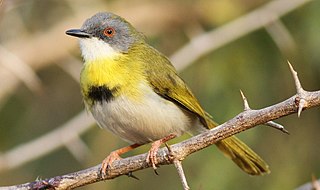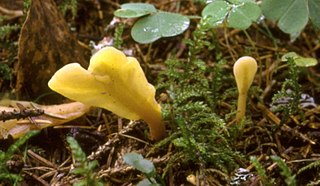
The yellow-breasted apalis is a species of bird in the family Cisticolidae.

Spathularia flavida, commonly known as the yellow earth tongue, the yellow fan, or the fairy fan, is an ascomycete fungus found in coniferous forests of Asia, Europe and North America. It produces a small, fan- or spoon-shaped fruit body with a flat, wavy or lobed cream to yellow colored "head" raised on a white to cream stalk. The height is usually approximately 2–5 cm (0.8–2.0 in), and up to 8 cm (3.1 in). The fungus fruits on the ground in mosses, forest duff or humus, and fruit bodies may occur singly, in large groups, or in fairy rings. The spores produced by the fungus are needle-like, and up to 95 micrometres long. Several varieties have been described that differ largely in their microscopic characteristics. S. flavida has been described by authorities variously as inedible, of unknown edibility, or edible but tough.

Ugia is a genus of moths in the family Erebidae erected by Francis Walker in 1858.

Spathularia is a genus of fungi in the family Cudoniaceae. Species in the genus are found in coniferous forests around the bases of conifers or near rotting logs.
Earias flavida is a moth of the family Nolidae. It was described by Cajetan Felder in 1861. It is found from the Indo-Australian tropics of India, Sri Lanka, Sumatra and Java to Samoa and Tonga.
Glaucostola flavida is a moth of the family Erebidae first described by William Schaus in 1905. It is found in French Guiana, Guyana and Trinidad.
Russula flavida is a member of the large mushroom genus Russula, described in 1880 by American botanist and mycologist Charles Christopher Frost and found in North America and parts of Asia. It has a bright yellow to orange yellow cap and stipe and white gills.

The Acantholipini are a tribe of moths in the family Erebidae.
Ugia amaponda is a species of moth in the family Erebidae. It is found in Kenya, South Africa and Zimbabwe.
Ugia calescens is a species of moth in the family Erebidae. It is found in Gabon.
Ugia duplicilinea is a species of moth in the family Erebidae. It is found in Ivory Coast and Nigeria.
Ugia egcarsia is a species of moth in the family Erebidae. It is found in Angola.

Ugia eugrapha is a species of moth in the family Erebidae first described by Charles Swinhoe in 1907. It is found in Indonesia and Thailand.
Ugia geometroides is a species of moth in the family Erebidae. It is found in Gabon.
Ugia malagasy is a species of moth in the family Erebidae. It is found in Madagascar.
Ugia mediorufa is a species of moth in the family Erebidae. It is found in India (Naga).
Ugia sestia is a species of moth in the family Erebidae. It is found in Gabon.
Ugia signifera is a species of moth in the family Erebidae. It is found in Indonesia (Sumatra) and on Borneo and Peninsular Malaysia. The species is found in various lowland habitats, ranging from forested areas to disturbed areas and coastal vegetation.

Libellula flavida, the yellow-sided skimmer, is a species of skimmer in the family of dragonflies known as Libellulidae. It is found in North America.






